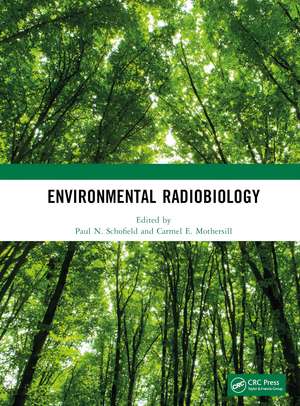Environmental Radiobiology
Editat de Paul N. Schofield, Carmel E. Mothersillen Limba Engleză Hardback – 17 oct 2023
The nuclear accidents in Chornobyl in 1986 and Fukushima in 2011 focussed the attention of the world on the vulnerability of ecosystems to radiation. In Chornobyl, there still remains an exclusion zone where levels are considered to be too high for people and impacts on terrestrial and aquatic ecosystems can still be measured 35 years later. In the area impacted by the Fukushima disaster, intense remediation is still under way at tremendous cost and causing widespread disruption to the environment. That accident impacted the terrestrial and marine ecosystems. In both accidents it became obvious that a radiation protection framework focussing on protection of “humans” (a single species) and using evacuation as a key strategy, was not sufficient to protect the natural environment. The complexity of ecosystems makes developing a protection framework very challenging but in order to even start the process it is vital to gather information about likely impacts of low dose exposures on wildlife and to develop monitoring tools to measure changes over time. This book contains reviews and original research aimed at filling our knowledge gaps about these important areas.
Environmental Radiobiology will be a key resource for academics, researchers, and advanced students of Radiobiology, Radioecology, Biology, Ecology, Biomedicine and Research Methods. The chapters included in this book were originally published as a special issue of International Journal of Radiation Biology.
Preț: 775.47 lei
Preț vechi: 1109.38 lei
-30% Nou
Puncte Express: 1163
Preț estimativ în valută:
148.45€ • 152.76$ • 125.14£
148.45€ • 152.76$ • 125.14£
Carte tipărită la comandă
Livrare economică 01-15 martie
Preluare comenzi: 021 569.72.76
Specificații
ISBN-13: 9781032557687
ISBN-10: 1032557680
Pagini: 226
Dimensiuni: 210 x 280 mm
Greutate: 1.08 kg
Ediția:1
Editura: CRC Press
Colecția CRC Press
ISBN-10: 1032557680
Pagini: 226
Dimensiuni: 210 x 280 mm
Greutate: 1.08 kg
Ediția:1
Editura: CRC Press
Colecția CRC Press
Public țintă
Postgraduate and UndergraduateNotă biografică
Paul N. Schofield is the University Professor of Biomedical Informatics at the University of Cambridge, UK, and an Adjunct Professor at The Jackson Laboratory, USA. His research focus is on experimental and informatics approaches to understanding human disease using model organisms. He has a long-standing interest in the biological effects of low dose ionizing radiation and FAIR data in radiobiology.
Carmel E. Mothersill is an Environmental Radiobiologist at McMaster University, Hamilton, Canada where she studies low dose radiation effects and development of biomarkers for wildlife. Her main goal is to identify ecosystem level bioindicators of environmental impact.
Carmel E. Mothersill is an Environmental Radiobiologist at McMaster University, Hamilton, Canada where she studies low dose radiation effects and development of biomarkers for wildlife. Her main goal is to identify ecosystem level bioindicators of environmental impact.
Cuprins
Introduction 1. Neglecting the ecosystemic dimension of life hinders efficient environmental protection from radiation and other hazards 2. What makes radiation protection so challenging? 3. Insight into the evolutionary profile of radio-resistance among insects having intrinsically evolved defence against radiation toxicity 4. The sine qua non of the fish invitrome today and tomorrow in environmental radiobiology 5. Environmental radiobiology of amphibians – knowledge gaps to be filled using cell lines 6. Radiation-induced transgenerational effects in animals 7. A review of the impact on the ecosystem after ionizing irradiation: wildlife population 8. Impact of nonionizing electromagnetic radiation on male infertility: an assessment of the mechanism and consequences 9. Environmental and industrial developments in radiation cataractogenesis 10. Bio-acoustic signaling; exploring the potential of sound as a mediator of low-dose radiation and stress responses in the environment 11. Radiation induces stress and transgenerational impacts in the cricket, Acheta domesticus 12. Evaluation of interactive effects of phosphorus-32 and copper on marine and freshwater bivalve mollusks 13. Combined action of gamma radiation and exposure to copper ions on Lemna minor L 14. Copper uptake in adult rainbow trout irradiated during early life stages and in non-irradiated bystander trout which swam with the irradiated fish 15. A pilot study of radiation-induced bystander effect in radio-adapting frogs at a radiologically contaminated site located on the chalk river laboratories property 16. Environmental radiation on large Japanese field mice in Fukushima reduced colony forming potential in hematopoietic progenitor cells without inducing genomic instability 17. Assessment of chromosome aberrations in large Japanese field mice (Apodemus speciosus) in Namie Town, Fukushima 18. Isolation of the effects of alpha-related components from total effects of radium at low doses 19. Investigation of Radon Sources, Health Hazard and Risks assessment for children using analytical and geospatial techniques in District Bannu (Pakistan) 20. From tangled banks to toxic bunnies; a reflection on the issues involved in developing an ecosystem approach for environmental radiation protection
Descriere
This book focuses on the impacts of anthropogenic radiation on wildlife and ecosystems and provides an in-depth look at the approaches and available tools we can use to gain information about biological effects of radiation in the environment.
